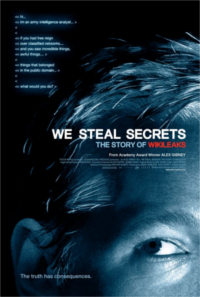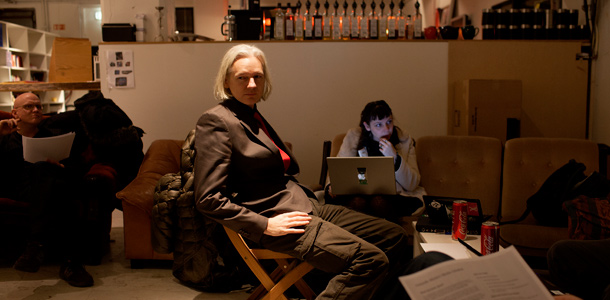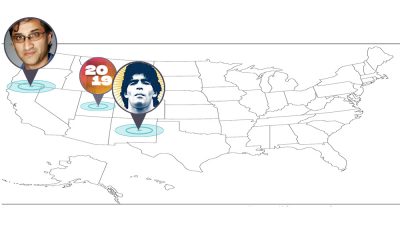Reviews
We Steal Secrets: The Story of Wikileaks | Review
Gibney Ciphers Assange’s Brain Child
 Back up a few years and you probably never had heard the name Julian Assange or his tiny little whistle-blowing website, WikiLeaks, but by 2010 both the name and infamous site were page one news. Acclaimed documentarian Alex Gibney, like many others, was taken with Assange’s bold vision to leak government and corporate secrets to the internet where they would be forever in the hands of the people, permanently available to anyone who wants them. With We Steal Secrets: The Story of WikiLeaks, Gibney profiles Assange and his startup with signature diligence, and in doing so he digs deep into the political perplexity that is the internet, and the story of the true purveyor of the Afghan War Logs, the Iraq War Logs and the Diplomatic cables, and US Army intelligence analyst Private Manning.
Back up a few years and you probably never had heard the name Julian Assange or his tiny little whistle-blowing website, WikiLeaks, but by 2010 both the name and infamous site were page one news. Acclaimed documentarian Alex Gibney, like many others, was taken with Assange’s bold vision to leak government and corporate secrets to the internet where they would be forever in the hands of the people, permanently available to anyone who wants them. With We Steal Secrets: The Story of WikiLeaks, Gibney profiles Assange and his startup with signature diligence, and in doing so he digs deep into the political perplexity that is the internet, and the story of the true purveyor of the Afghan War Logs, the Iraq War Logs and the Diplomatic cables, and US Army intelligence analyst Private Manning.
Beginning nowhere near where you’d expect, we are first faced with a former NASA employee who gives a rundown of the 1989 system attack by the famed WANK computer worm which was originally thought as a threat to the Galileo spacecraft. Though he has never confirmed or denied his involvement, Assange, under his former hacking tag ‘Mendax’, is believed to be one of the brains behind the worm’s creation, adding to his public mystique. He founded WikiLeaks in 2006 with a mission to ‘to radically shift regime behavior’ by releasing documents previously kept secret, but it wasn’t until Assange came in contact with a fed up soldier who was struggling with gender identity named Bradley Manning where the brewing future storm would switch to tsunami status. Manning had access to massive amounts of disclosed government documents and made the decision to upload them to WikiLeaks in a fit of rage and confusion after reaching out to famed hacker Adrian Lamo, who eventually turned him in.
As news of Manning hit the fan and WikiLeaks aligned with major news outlets such as The Guardian and The New York Times to release mass amounts of secret documents, media chaos seemed to ensue, with Assange being the eye of the storm. Though he took the pressure on himself, he became a target for political attack, but under the microscope he handled it fairly well, until he was accused of sexual assault by two former associates, outright denying both instances. Instead of separating himself and his personal issues from the publicity of WikiLeaks, he chose to publicly combine their struggle, alienating those who worked with him. Due to his poor handling of the situation, he’s now become a wanted man and a political pariah currently living in the Ecuadorian embassy in London out of fear of extradition to Sweden where he awaits charges. Manning, after nearly three years without a trial, remains unlawfully imprisoned, awaiting his day in court.
Gibney seems used to constructing sprawling, politically charged documentaries. Here he seems at ease, slicing and dicing Assange and Manning’s globe-trotting tale into a briskly paced, yet dense timeline deconstruction. At the center of it all, the internet is the key apparatus necessary for these events to unfold and Gibney makes use of this fact. The film frequently makes visual reference to the free flow of information through stylishly designed CG digital networks, reminding us of where all this went down. We also spend much time with the real online conversations between Lamo and Manning, displayed as unadorned text in real time as if the two were conversing live. The simplistic effect is strangely engaging and startlingly moving. Lamo and Bradley are both tragic figures in contrast to the brazen charisma of Assange, and their temporary synthesis of blind trust and Lamo’s ensuing betrayal is the soul of the film.
Structured around the internet-based architecture of WikiLeaks, Assange’s professional pivot points, and Manning’s surprise security breach, the film features plenty of critical talking heads who deeply enrich the foray. Former WikiLeaks employee James Bell, Guardian reporters who worked on several of the leaks, Manning’s former military supervisor, Lamo himself, one of the two women who accused Assange of sexual assault, and even former C.I.A. director Michael Hayden all appear, each speaking frankly about their views on the history of WikiLeaks, Assange’s rise and fall, and the controversy caused by the internet’s free flowing information.
Though Julian was approached by Gibney to give his own accounts, he ultimately refused to cooperate, appearing only in archival footage. We are left to ponder the known facts, coming to our own opinions. We Steal Secrets forms an critical bookend for what may be the subversion of WikiLeaks and its obstinate editor-in-chief with enthralling acumen. Gibney both accedes to their cultural impact and questions their perverse enterprise with cunning narrative agility, noting that when there is need, some online unknown will surely take up their cause, for better or worse.
Reviewed on January 24th at the 2012 Sundance Film Festival – DOCUMENTARY PREMIERES Programme. 127 Min






























